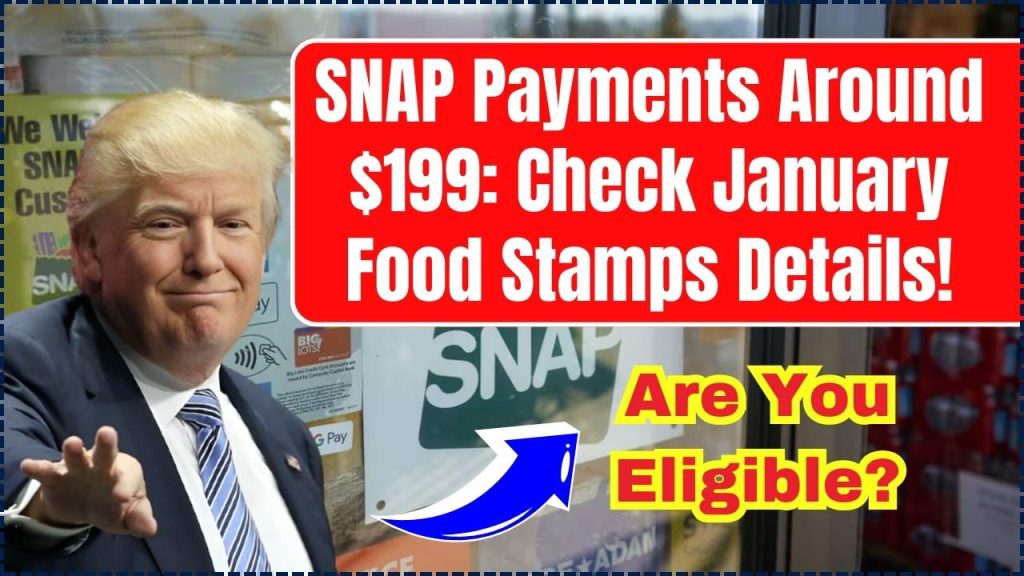
SNAP Payments Around $199: The Supplemental Nutrition Assistance Program (SNAP), commonly known as food stamps, is a lifeline for millions of Americans, providing essential financial aid to purchase nutritious food. As of January 2025, updates to SNAP payments have introduced revised benefit amounts, eligibility criteria, and application processes. Whether you’re a current beneficiary or considering applying, understanding these changes is crucial to ensuring you receive the support you need. These updates reflect adjustments to inflation, policy changes, and evolving economic conditions, making it vital to stay informed.
This comprehensive guide will break down everything you need to know about SNAP payments in January 2025, including expanded eligibility requirements, new benefit amounts, detailed application steps, and practical advice for maximizing your benefits.
SNAP Payments Around $199
| Key Information | Details |
|---|---|
| Average Monthly Payment | Around $199 per household member |
| Eligibility Requirements | Based on income, household size, and residency |
| Maximum Monthly Benefits | $301 (1 person), $1,728 (8+ people); adjusted annually for inflation |
| Application Process | Online, by mail, or in person at local SNAP offices |
| Updated Policies | New work requirements for adults aged 52-54, inflation-adjusted benefits |
| Official Resources | USDA SNAP Website |
SNAP remains a vital resource for millions of Americans, providing crucial assistance to ensure access to nutritious food. Understanding the updated benefit amounts, expanded eligibility requirements, and streamlined application process for January 2025 can help you or your loved ones make the most of this essential program.
Key Takeaway: Stay informed about changes to SNAP, gather necessary documentation, and apply early to secure the benefits you’re entitled to. For more information, visit the USDA SNAP Website or contact your state’s SNAP office.
What Is SNAP and Why Is It Important?
SNAP is a federal assistance program administered by the U.S. Department of Agriculture (USDA). It provides low-income households with financial aid to purchase eligible food items, ensuring access to essential nutrition. Benefits are distributed monthly through an Electronic Benefits Transfer (EBT) card, which functions like a debit card at authorized retailers.
Why SNAP Matters
SNAP addresses food insecurity and promotes better health by enabling households to purchase fresh fruits, vegetables, dairy, and protein-rich foods. It plays a pivotal role in reducing hunger, supporting local economies, and improving the overall well-being of recipients. As of 2024, over 41 million Americans relied on SNAP benefits, demonstrating its critical importance in combating hunger and fostering economic stability.
Additionally, SNAP benefits contribute to broader economic growth. According to USDA data, every dollar spent on SNAP generates approximately $1.50 in economic activity, creating a ripple effect that benefits local businesses and communities.
SNAP Benefit Amounts in January 2025
Maximum Monthly Benefits
The maximum SNAP benefits depend on household size and are adjusted annually to account for inflation. For fiscal year 2025, the maximum monthly benefits for households in the 48 contiguous states and Washington, D.C., are as follows:
| Household Size | Maximum Monthly Benefit |
|---|---|
| 1 person | $301 |
| 2 people | $555 |
| 3 people | $790 |
| 4 people | $1,004 |
| 5 people | $1,192 |
| 6 people | $1,430 |
| 7 people | $1,504 |
| 8 people | $1,728 |
| Each additional person | +$220 |
Average Benefits
While the maximum benefit provides a ceiling, the average benefit offers a more realistic picture for most households. For example, a household of three might receive an average of $594 monthly, depending on income and allowable deductions. These averages underscore the program’s flexibility in accommodating diverse financial situations while providing meaningful support.
Adjustments for Inflation
To ensure benefits keep pace with rising living costs, SNAP payments are recalculated annually based on the USDA’s Thrifty Food Plan. This adjustment reflects increases in food prices and ensures recipients maintain access to essential nutrition despite inflationary pressures.
Expanded Eligibility Criteria for SNAP in 2025
Eligibility for SNAP benefits is determined by federal guidelines, which consider factors like income, household size, and expenses. Recent updates have expanded eligibility to address growing economic challenges.
1. Income Limits
- Gross Income: Must not exceed 130% of the federal poverty level (FPL). For a family of three, this equates to approximately $2,495 per month.
- Net Income: After allowable deductions, net income must fall below the poverty line.
2. Household Composition
SNAP benefits are calculated based on the number of people in your household and their characteristics, such as age, disability status, and special needs. For example, households with seniors or disabled members may qualify for higher deductions, increasing their net benefits.
3. Work Requirements
- Able-Bodied Adults Without Dependents (ABAWDs): Individuals aged 18-54 must work or participate in a work program for at least 20 hours per week.
- New Policy Update: Stricter work requirements now apply to adults aged 52-54, reflecting recent legislative changes aimed at encouraging workforce participation.
- Exemptions: Seniors, individuals with disabilities, caregivers, and certain students may be exempt from work requirements.
4. Residency and Citizenship
Applicants must reside in the state where they apply and be U.S. citizens or meet specific non-citizen requirements. Certain legal non-citizens, such as refugees and asylees, may also qualify.
5. Asset Limits
Countable resources, such as cash and bank accounts, must fall below $2,750 for most households. However, higher limits apply to households with elderly or disabled members. Exclusions include primary homes, retirement accounts, and certain vehicles.
Who Qualifies for the $1,400 Stimulus? The Answer May Surprise You!
Imminent Stimulus Check Payments: Millions of Dollars Set to Be Distributed!
Social Security Contribution Rules Explained: A Law Every Worker Should Know
SNAP Payments Around $199 Apply for SNAP Benefits
Applying for SNAP benefits is a straightforward process. Follow these steps to ensure a successful application:
- Gather Documentation:
- Proof of identity (e.g., driver’s license or state ID).
- Proof of residency (e.g., utility bill or lease agreement).
- Income verification (e.g., pay stubs, tax returns).
- Information on household expenses (e.g., rent, medical bills, childcare costs).
- Submit Your Application: Applications can be submitted in three ways,
- Online: Visit your state’s SNAP website to complete and submit the application form.
- By Mail: Request a paper application from your local SNAP office and send it back with the required documents.
- In Person: Submit your application directly at your local SNAP office.
- Attend an Interview: Most applicants must complete an interview, which may be conducted over the phone or in person, to verify their eligibility and provide additional information. Preparing your documents in advance can expedite this process.
- Receive a Decision: You will be notified of your eligibility and benefit amount within 30 days of submitting your application. Expedited benefits may be available for households in urgent need, providing access to resources within seven days.
- Use Your EBT Card: Approved beneficiaries will receive an EBT card loaded with their monthly benefits. Use this card to purchase eligible food items at authorized retailers, including supermarkets, farmers’ markets, and certain online grocery platforms.
FAQs On SNAP Payments Around $199
1. What can I buy with SNAP benefits?
SNAP benefits can be used to purchase food items such as fruits, vegetables, meat, dairy, and bread. Non-food items, alcohol, vitamins, and prepared foods are not eligible. However, certain states allow SNAP purchases at participating farmers’ markets, promoting fresh and local produce.
2. Can I qualify if I’m unemployed?
Yes, unemployed individuals can qualify for SNAP benefits if they meet income and other eligibility requirements. Work requirements may still apply for ABAWDs, but exemptions are available for those actively seeking employment or participating in training programs.
3. How often are SNAP benefits distributed?
SNAP benefits are distributed monthly. The exact payment date depends on your state’s schedule, which often aligns with the last digit of your Social Security number or case number.
4. What happens if I don’t use all my benefits in a month?
Unused benefits roll over to the next month. However, they must be used within 12 months to avoid expiration. Regularly checking your balance ensures you make the most of your available funds.
5. Can college students qualify for SNAP?
Yes, but eligibility is limited. Students must meet specific criteria, such as working at least 20 hours per week, caring for dependents, or participating in eligible education and training programs.
Recent Updates to SNAP in 2025
1. Inflation Adjustments
SNAP benefits have been increased to reflect the rising cost of living. For example, the maximum benefit for a family of four in the contiguous U.S. has risen slightly to $1,004. These adjustments ensure recipients maintain their purchasing power amid economic challenges.
2. Stricter Work Requirements
Able-bodied adults aged 52-54 must now comply with work requirements to maintain eligibility, expanding the previous age range. This policy aims to encourage workforce participation while providing support for those in need.
3. State-Specific Changes
Some states have introduced additional benefits or streamlined application processes to improve access for eligible households. Innovations include mobile-friendly applications and expanded outreach efforts in underserved communities.

